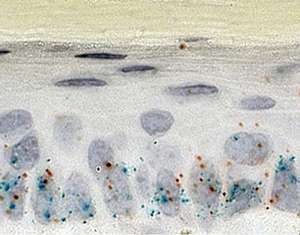How renewal and differentiation of the skin's stem cells are regulated

The human body maintains a healthy layer of skin thanks to a population of stem cells that reside in the epidermis. Previously, the signals responsible for regulating these so-called 'interfollicular epidermal stem cells' (IFESCs) were unclear, but now scientists in Singapore and the United States have shown that these cells secrete proteins in the Wnt signaling pathway to control their own balance between renewal and differentiation.
"The mechanism of stem cell function that we describe is novel to the skin and, as far as we know, also unprecedented in the entire stem cell field," says Xinhong Lim of the A*STAR Institute of Medical Biology, who led the study. "Skin stem cells themselves can be a source of stem cell self-renewing signals. This expands the paradigm for how mammalian stem cells are regulated."
Lim and his colleagues focused on Wnt proteins because of their well-established roles in stem cell maintenance and hair growth. To determine if IFESCs respond to Wnt signals, the researchers created transgenic mice in which they could visually track the fate of cells producing Axin2, a protein triggered by Wnt activity.
They discovered that Axin2 was expressed by cells that contribute to wound healing, found in the deepest layer of the epidermis (see image). Through detailed molecular analysis, the team confirmed that these cells were IFESCs. In addition, they noted that the same stem cells also expressed several Wnt family genes themselves. Together, these findings indicate that IFESCs are both the source and the target of Wnt signals.
The researchers concluded that the self-renewal of IFESCs is maintained by an autocrine or self-stimulating loop of Wnt production. "The stem cells, rather than a separate stem cell niche, regulate epidermal thickness and regeneration," Lim says.
These results led the team to question how the IFESCs could escape this regulatory loop and commence the differentiation process. Seeking answers, Lim and his colleagues tracked the expression patterns of Wnt inhibitors in the skin.
They found that while the stem cells also secreted Wnt inhibitors, these signals localized to the cells situated above the stem cell compartment, reinforcing differentiation there. "By producing both an autocrine Wnt signal and a paracrine Wnt inhibitor," Lim explains, "the stem cells in the skin act as the organizing center for the tissue."
The team's discovery could lead to new therapies that manipulate Wnt signaling to improve wound healing. According to Lim, it could advance skin stem cell culture protocols, helping scientists to grow skin grafts more efficiently.
More information: Lim, X., Tan, S. H., Koh, W. L. C., Chau, R. M. W., Yan, K. S. et al. "Interfollicular epidermal stem cells self-renew via autocrine Wnt signaling." Science 342, 1226–1230 (2013). dx.doi.org/10.1126/science.1239730

















